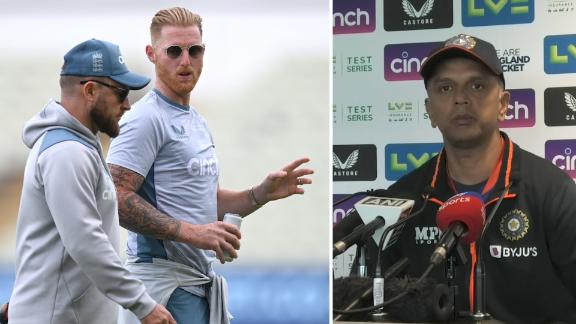England 284 (Bairstow 106, Siraj 4-66, Bumrah 3-68) and 378 for 3 (Root 142*, Bairstow 114*, Lees 56, Crawley 46) beat India 416 (Pant 146, Jadeja 104, Anderson 5-60) and 245 (Pujara 66, Pant 57, Stokes 4-33) by seven wickets
England came to Edgbaston having gunned down targets of 277, 299 and 296 in their last three Test matches. On Tuesday they made it four in a row, pulling off their highest successful chase in Test cricket as Joe Root and Jonny Bairstow completed sparkling unbeaten hundreds, making India's celebrated bowling attack look utterly bereft of ideas in near-perfect batting conditions.
Root sealed victory with a reverse-sweep, a symbolic moment if there ever was one. He played the shot or variants thereof - including a reverse-lap off Shardul Thakur for a six over the slips - four times in the closing overs of the game, as England picked off the last 46 runs of their target in just 34 balls. Pure Bazball.
This has been an unusual summer of relatively flat pitches and an exceedingly flat batch of Dukes balls, but this sequence of audacious chases has come against two of the best fast-bowling attacks in the world - attacks that came to England last year and went away with a 1-0 series win and a 2-1 series lead respectively. A remarkable achievement for Ben Stokes and Brendon McCullum, the new captain and coach, even if the long-term viability of their all-out-attacking philosophy will be put to test more rigorously in due course, when England play in more bowling-friendly conditons.
England began the last day needing 119, and India needing seven wickets. England had never successfully chased a target of this magnitude, and India had never lost while defending one of this magnitude. Now, venomous early bursts from Jasprit Bumrah and Mohammed Shami were India's only way back into the game.
A ball-change in the second over of the morning - two balls had gone out of shape in the first 59 overs of England's innings, and the third would also be replaced by the time the match was done - brought India a brief window when the replacement Dukes moved around appreciably, but it didn't translate into a wicket. Bumrah and Shami beat the edges of both batters, and on one occasion Root inside-edged the ball narrowly past his stumps, but the two fast bowlers were also erratic, drifting too wide or too straight, with Shami conceding eight byes in the space of two overs.
These errors were ruthlessly punished, and often even reasonably good balls. Bairstow met an off-stump ball from Bumrah with a full face to punch it between mid-on and midwicket, and Root opened his bat-face late to routinely steer good-length balls in the corridor either side of gully.
One such back-cut brought up Root's 28th hundred in Test cricket, and England were rushing along by this stage, with Root hitting five fours in the space of just four overs. At one stage, it appeared as if Root could dash to the target all by himself; Bairstow had beaten Root to 90, but he was still in the 90s when Root had moved to 135.
Bairstow wouldn't be denied his second hundred of the match, of course, and his fourth in his last five Test innings, getting there with a scampered single after pushing Ravindra Jadeja into the leg side. He celebrated with three back-to-back boundaries in the next over - slapped through point, drilled down the ground, pulled through midwicket - with Mohammed Siraj at the receiving end.
That over, the penultimate over of the match, left Siraj nursing figures of 15-0-98-0. He went for nearly six an over in the first innings too, though there were four wickets to go with it. Thakur, meanwhile, conceded 113 in 18 overs across the two innings while taking just the one wicket. These two were part of an India attack that created sustained pressure on England last summer. On this visit, the two of them and Ravindra Jadeja, who extracted very little from the pitch while bowling a negative line from left-arm over, left Bumrah and Shami carrying too much of a burden to manage by themselves.




